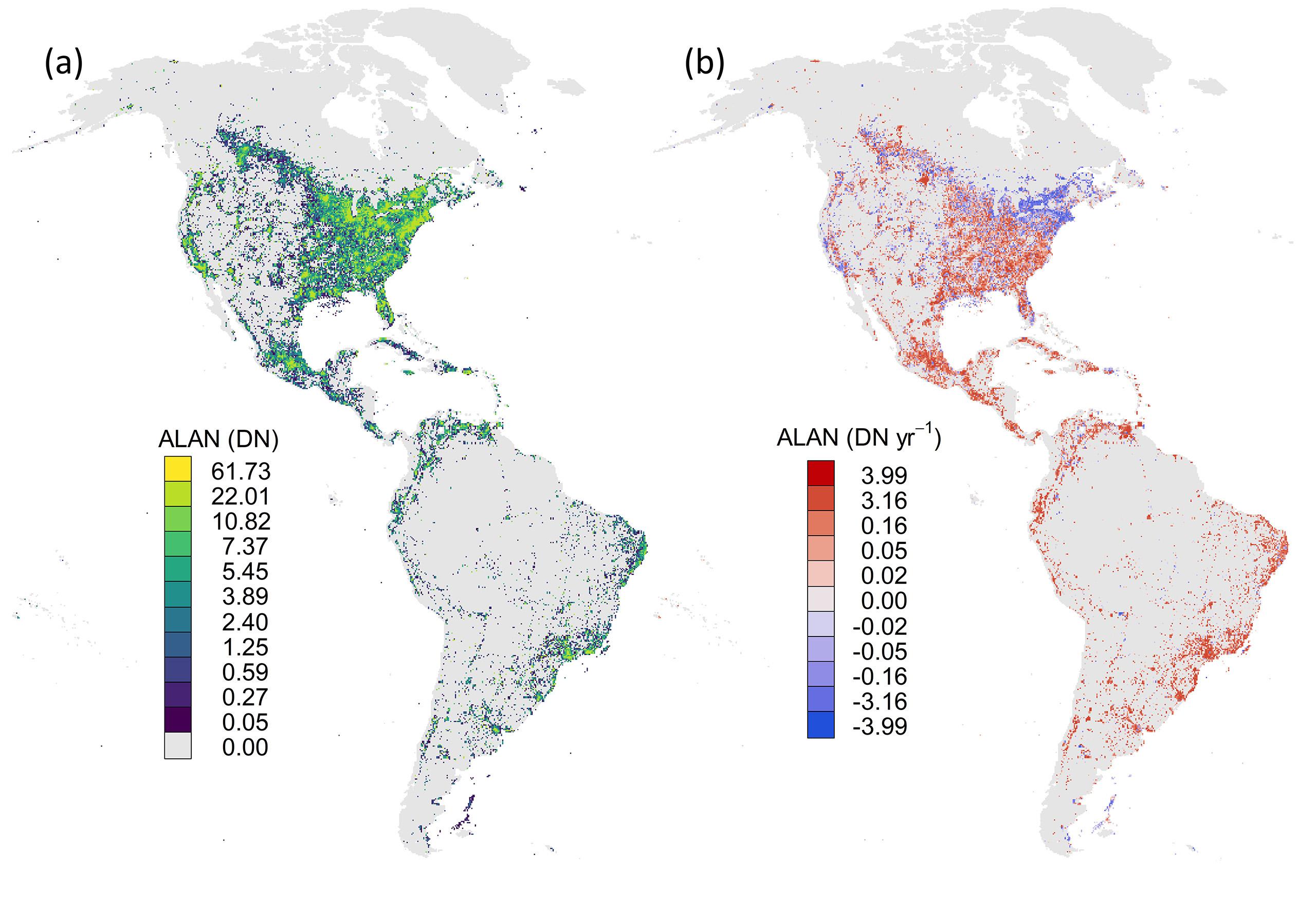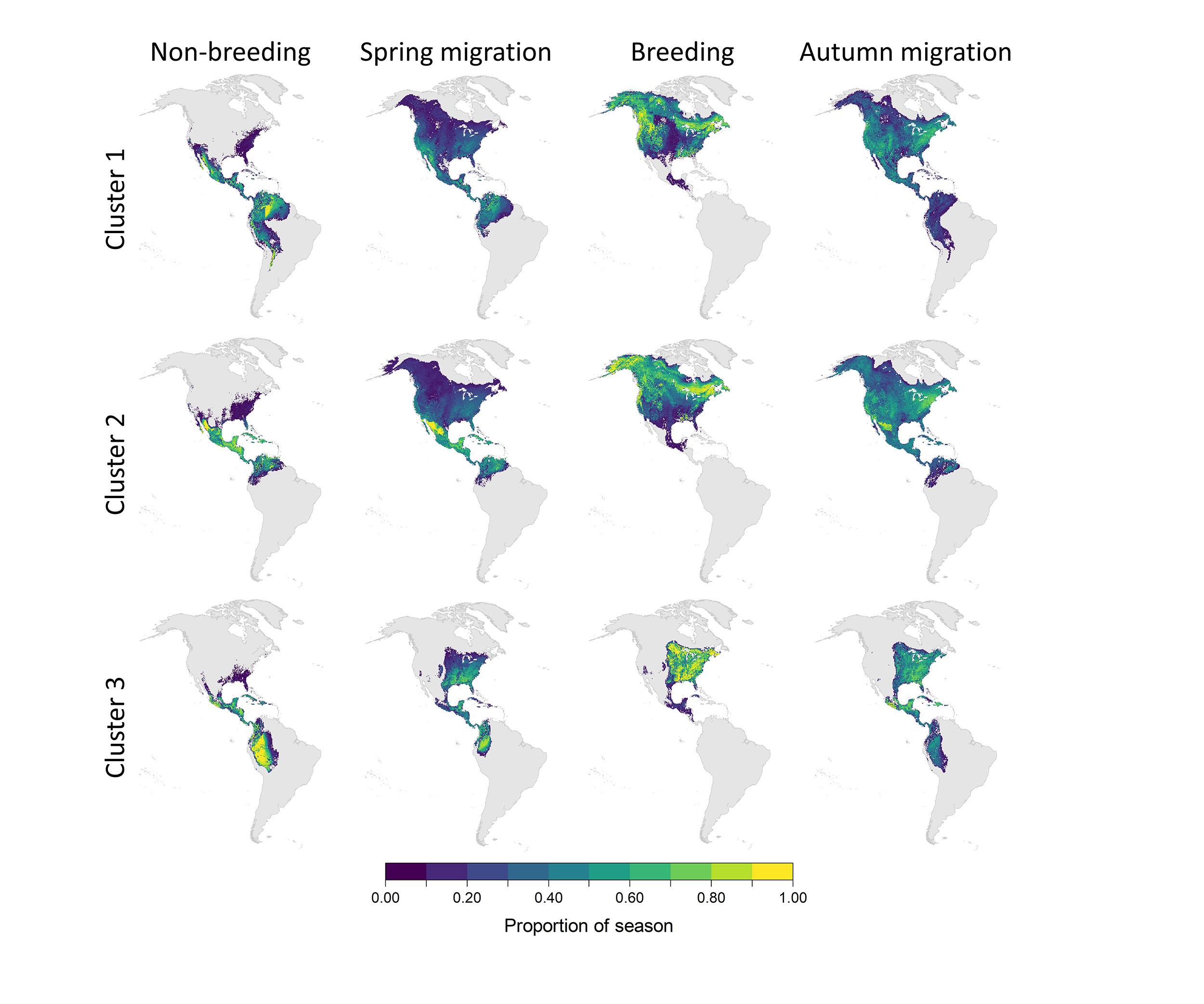study tracks artificial-light impact on migratory birds
Analysis of 42 species in Western hemisphere suggests most
effective steps for reducing city lights’ harm
Human-made lights at night bring us benefits, but also carry downsides to human health and the environment. One of the downsides of artificial light is that it interferes with the movement of migratory birds. A study led by scientists at the Cornell Lab of Ornithology used PSC’s Bridges system to analyze the effects of night-time artificial light on birds in the Western hemisphere as recorded in a vast, crowdsourced database collected by volunteer bird watchers. Their results suggest places in North and Central America where stopping or reversing the spread of city lights at night could most help these bird species.

Above: (a, left) The brightness of artificial lighting at night (ALAN) in the Western hemisphere; (b, right): changes over time in ALAN between 1992 and 2013 (red increasing, blue decreasing).
.
Why It’s Important
In countless ways, artificial light has helped us be richer and more productive, turning night into day. But with those benefits come downsides. Contrary to popular belief, lighting up cities at night doesn’t seem to reduce crime rates. And interfering with our natural day-night rhythms via artificial light has been linked to a surprising array of medical problems, including increased breast-cancer risk, sleep conditions, gastrointestinal illness, mood disorders and even cardiovascular disease. To make matters worse, our brightly lit nighttime cities are playing havoc with the environment, harming animals as different as sea turtles, frogs and toads, fish, bees, monarch butterflies and Atlantic salmon.
Frank A. La Sorte (pictured here) of the Cornell Lab of Ornithology and his colleagues there and at Colorado State University and the University of St. Andrews in Scotland were concerned about the effects that artificial light has on migratory birds. Scientists knew that artificial light could confuse birds’ eyes, interfering with their ability to “see” the Earth’s north-south magnetic field. Instead of following magnetic lines to where they need to go, they circle the lights. The artificial lights surrounding cities also tend to draw migrating birds to urban parks. The parks themselves wouldn’t be such a bad stopover if it weren’t for the fact that they’re typically not big enough to rest and refuel an entire migrating flock for the next leg of their journey.
University and the University of St. Andrews in Scotland were concerned about the effects that artificial light has on migratory birds. Scientists knew that artificial light could confuse birds’ eyes, interfering with their ability to “see” the Earth’s north-south magnetic field. Instead of following magnetic lines to where they need to go, they circle the lights. The artificial lights surrounding cities also tend to draw migrating birds to urban parks. The parks themselves wouldn’t be such a bad stopover if it weren’t for the fact that they’re typically not big enough to rest and refuel an entire migrating flock for the next leg of their journey.
“The big message is that [the effects of artificial light] are generally increasing across these species’ distributions, especially during migration within Central America, where they occur in high numbers and high concentrations. Artificial light at night during migration is very dangerous because it interferes with their ability to navigate, resulting in migrating birds wasting time, energy and increasing the risk of colliding with structures.”—Frank A. La Sorte, Cornell University
To better understand how artificial light affects migratory birds at the large scale, the team employed computerized analysis of a massive database compiled by volunteer bird watchers. Called “eBird,” this database promised to — pun noted — shed light on how artificial illumination at night affects the movements of 42 migratory bird species in the Western hemisphere. To undertake this data-hungry analysis, they used the Bridges advanced research computer at PSC.
How PSC Helped
The eBird database was a treasure trove for La Sorte’s computations. To date, eBird contains over a billion observations by 772,800 bird watchers worldwide. It also posed challenges. For one thing, bird watching, which originated in Europe, has many more adherents in developed nations than in developing nations. Because charting the effects of these bird species required data from North, Central and South America, the observations in those regions would need to be corrected for the differing numbers of bird watchers in each place.
This issue only added a layer of complexity to what was already a vast “Big Data” problem. The researchers used a cluster analysis to identify species with similar weekly associations with artificial lighting at night (ALAN) trends. They sub-sampled the data repeatedly and then averaged the predictions that those samples made. Not unlike the many averaged predictions that meteorologists use to chart storm movements, such repeated analysis gave La Sorte and his collaborators a much better idea of the likely movements of each species as they bred, migrated and wintered. By looking at how much the prediction varied across the ensembles, it also gave them a sense of how large the uncertainty would be in the overall prediction. But such repeated sampling of massive data demanded huge computer memory — the same as RAM on a personal computer. Bridges offered hundreds of computing nodes with memory as large as 12 terabytes (TB) for each — almost 400 times as much RAM as a top-end laptop. In total, the now-retired system had more than 270 TB of RAM.
“Bridges was essential; this is something you can’t easily do using even [typical] high performance computers. You need these [memory-intensive] resources … because these models … are data-hungry.”—Frank A. La Sorte, Cornell Lab of Ornithology

Above: Seasonal distributions of 42 night-migrating passerine bird species, grouped into three clusters based on how their weekly patterns of occurrence were associated with changes over time in artificial light at night.
La Sorte’s analysis of the eBird data revealed complicated associations with night-time lighting for migrating birds. The prevalence of one cluster of species that breed in northeastern and western North America were associated with increasing artificial light during the breeding season but not the nonbreeding season. Species found in South America during the nonbreeding season, by comparison, were associated with strongly increasing artificial lights in Central America during spring migration. Birds that spent their breeding season in the southeast of North America were associated with increasing artificial lights throughout the year and especially during migration.
While a bit complicated, this pattern did suggest some steps we can take to reduce artificial lights’ effects on migratory birds. Eliminating unnecessary night lighting in Central America, especially in the spring, could reduce harm to the most birds of the most species during migration. Reducing the expansion of artificial lighting in southeast North America during the breeding season and in Central America during the nonbreeding season would produce the most benefit outside of the migratory season. The scientists published their results in the journal Ecosphere in March 2022.
The eBird modeling team is now working with Bridges-2, Bridges’ successor system. They generated occurrence estimates for 1,000 species last year and are currently computing population-trend estimates for about 400 species. Their aim will be to generate occurrence estimates for 2,500 species and population trend estimates for 750 species across their full ranges. In addition, they’ll be estimating year-to-year population trends and trajectories for the 2007-2021 period for at least 750 species.
